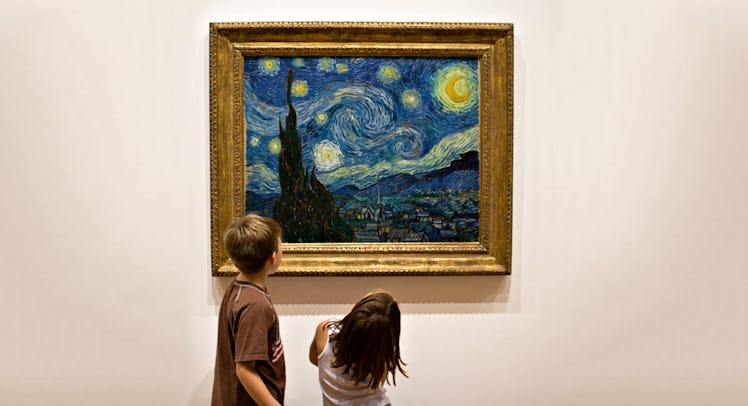Your Kids Appreciate Van Gogh More Than You Do
When children look at Van Goghs, they're attracted to bright colors. But when adults look at those same paintings, they are jaded by what they already know.

Adults and children employ different mental strategies to look at Van Gogh paintings, according to a new study. Researchers invited 12 children and 12 adults to an art museum in Amsterdam, and monitored their pupil movements as they examined five classic, if not necessarily famous, Van Goghs. They found that children explored the paintings with involuntary “bottom-up processes” while adults took in their daily dose of art using a “top-down process.” The adults were worse at seeing the art. They missed the painting for the context. Kids saw it just fine.
“When children look at paintings what they see is mainly guided by physical features, for instance bright patches of color,” coauthor on the study Francesco Walker, a PhD candidate at the University of Twente in the Netherlands, told Fatherly. “When adults look at pictures what they see is much more influenced by what they already know about the painting and the artist.”
This is not the first study to suggest that children are guided by instinct, while adults tend to bring the full weight of their experiences to even an art show. Top-down attentional control describes how we focus our attention on our personal goals or prior knowledge. It’s the type of focus you use when you’re frantically searching for your kid in a crowded room. Bottom-up attentional control, on the other hand, is more primal—it’s the kind of attention you reserve for focusing on the dining room when you hear a crash that sounds achingly like expensive china. Unsurprisingly for any parent, studies have shown that kids make far more use of bottom-up attentional control than adults, flitting their attention from one bright color or noise to another.
But this is the first study to bring that theory into practice—with a dash of art appreciation. Walker and his colleagues conceived the Van Gogh Museum Eye-Tracking Project in part because “Van Gogh uses a unique painting style,” Walker says. “Size, depth, color of the paintings…make the overall aesthetic experience so special and, at the same time, so hard to replicate in a laboratory setting. In some of his artworks, such as the ones included in our study, it is difficult to grasp all the different features of the painting. This made it perfect for our study, since we could then try to direct adults and children’s attention toward these details.”
For the study, Walker and colleagues invited 12 adults between the ages of 20 and 29 and 12 children between the ages of 11 and 12 to the Van Gogh Art Museum in Amsterdam. They were ushered into a room with five relatively unknown Van Goghs (decreasing the odds that one of them had seen the painting before): “Daubigny’s Garden”, “View of Auvers”, “Farmhouse”, “Landscape at Twilight”, and “Tree Roots”. Each participant wore a mobile eye-tracking device, and a backpack containing a laptop that recorded how they were examining each painting.
Children, the data revealed, started by focusing on the stand-out features of each painting (the brightest colors, the most obvious items) while adults initially focuses on the more understated features of the painting. After curators read descriptions of the artwork to both children and adults, the children altered how they looked at the paintings and began focusing on the less salient features. The adults continued using top-down processing, unmoved by the descriptions.
Walker says the findings may help curators design more family-friendly museums. “Understanding how children and adults see the paintings can help museum educators to develop a more tailored museum experience for the two groups,” he says. Outside of art appreciation, Walker adds that the study could inform further inquiry into bottom-up and top-down processing and how these two modes of thinking influence our everyday lives.
But for dads who just want their kids to get the most out of the museum, Walker’s advice is simple—keep what your foggy memories from art history class to yourself. “They will see them differently from you. Let them enjoy the paintings on their own terms,” he says.
“Don’t try to teach them.”
This article was originally published on